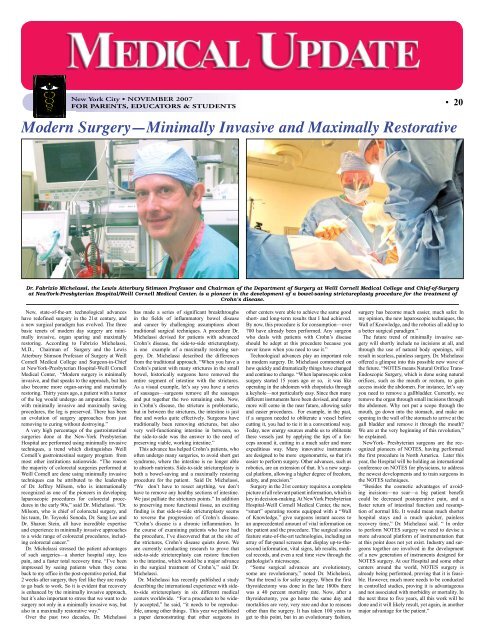Download PDF - Education Update
Download PDF - Education Update
Download PDF - Education Update
You also want an ePaper? Increase the reach of your titles
YUMPU automatically turns print PDFs into web optimized ePapers that Google loves.
New York City • NOVEMBER 2007For Parents, Educators & Students • 20Modern Surgery—Minimally Invasive and Maximally RestorativeDr. Fabrizio Michelassi, the Lewis Atterbury Stimson Professor and Chairman of the Department of Surgery at Weill Cornell Medical College and Chief-of-Surgeryat NewYork-Presbyterian Hospital/Weill Cornell Medical Center, is a pioneer in the development of a bowel-saving strictureplasty procedure for the treatment ofCrohn’s disease.New, state-of-the-art technological advanceshave redefined surgery in the 21st century, anda new surgical paradigm has evolved. The threebasic tenets of modern day surgery are minimallyinvasive, organ sparing and maximallyrestoring. According to Fabrizio Michelassi,M.D., Chairman of Surgery and the LewisAtterbury Stimson Professor of Surgery at WeillCornell Medical College and Surgeon-in-Chiefat NewYork-Presbyterian Hospital-Weill CornellMedical Center, “Modern surgery is minimallyinvasive, and that speaks to the approach, but hasalso become more organ-saving and maximallyrestoring. Thirty years ago, a patient with a tumorof the leg would undergo an amputation. Today,with minimally invasive and maximally savingprocedures, the leg is preserved. There has beenan evolution of surgery approaches from justremoving to curing without destroying.”A very high percentage of the gastrointestinalsurgeries done at the New-York PresbyterianHospital are performed using minimally invasivetechniques, a trend which distinguishes WeillCornell’s gastrointestinal surgery program frommost other institutions nationwide. “The reasonthe majority of colorectal surgeries performed atWeill Cornell are done using minimally invasivetechniques can be attributed to the leadershipof Dr. Jeffrey Milsom, who is internationallyrecognized as one of the pioneers in developinglaparoscopic procedures for colorectal proceduresin the early 90s,” said Dr. Michelassi. “Dr.Milsom, who is chief of colorectal surgery, andhis team, Dr. Toyooki Sonoda, Dr. Sang Lee andDr. Sharon Stein, all have incredible expertiseand experience in minimally invasive approachesto a wide range of colorectal procedures, includingcolorectal cancer.”Dr. Michelassi stressed the patient advantagesof such surgeries—a shorter hospital stay, lesspain, and a faster total recovery time. “I’ve beenimpressed by seeing patients when they comeback to my office in the post-operative period, that2 weeks after surgery, they feel like they are readyto go back to work. So it is evident that recoveryis enhanced by the minimally invasive approach,but it’s also important to stress that we want to dosurgery not only in a minimally invasive way, butalso in a maximally restorative way.”Over the past two decades, Dr. Michelassihas made a series of significant breakthroughsin the fields of inflammatory bowel diseaseand cancer by challenging assumptions abouttraditional surgical techniques. A procedure Dr.Michelassi devised for patients with advancedCrohn’s disease, the side-to-side strictureplasty,is one example of a maximally restoring surgery.Dr. Michelassi described the differencesfrom the traditional approach. “When you have aCrohn’s patient with many strictures in the smallbowel, historically surgeons have removed theentire segment of intestine with the strictures.As a visual example, let’s say you have a seriesof sausages—surgeons remove all the sausagesand put together the two remaining ends. Now,in Crohn’s disease, the stricture is problematic,but in between the strictures, the intestine is justfine and works quite effectively. Surgeons havetraditionally been removing strictures, but alsovery well-functioning intestine in between, sothe side-to-side was the answer to the need ofpreserving viable, working intestine.”This advance has helped Crohn’s patients, whooften undergo many surgeries, to avoid short gutsyndrome, where the intestine is no longer ableto absorb nutrients. Side-to-side strictureplasty isboth a bowel-saving and a maximally restoringprocedure for the patient. Said Dr. Michelassi,“We don’t have to resect anything, we don’thave to remove any healthy sections of intestine.We just palliate the strictures points.” In additionto preserving more functional tissue, an excitingfinding is that side-to-side strictureplasty seemsto reverse the progression of Crohn’s disease.“Crohn’s disease is a chronic inflammation. Inthe course of examining patients who have hadthe procedure, I’ve discovered that at the site ofthe strictures, Crohn’s disease quiets down. Weare currently conducting research to prove thatside-to-side strictureplasty can restore functionto the intestine, which would be a major advancein the surgical treatment of Crohn’s,” said Dr.Michelassi.Dr. Michelassi has recently published a studydescribing the international experience with sideto-sidestrictureplasty in six different medicalcenters worldwide. “For a procedure to be widelyaccepted,” he said, “it needs to be reproducible,among other things. This year we publisheda paper demonstrating that other surgeons inother centers were able to achieve the same goodshort- and long-term results that I had achieved.By now, this procedure is for consumption—over700 have already been performed. Any surgeonwho deals with patients with Crohn’s diseaseshould be adept at this procedure because younever know when you need to use it.”Technological advances play an important rolein modern surgery. Dr. Michelassi commented onhow quickly and dramatically things have changedand continue to change. “When laparoscopic colonsurgery started 15 years ago or so, it was likeoperating in the abdomen with chopsticks througha keyhole—not particularly easy. Since then manydifferent instruments have been devised, and manymore will come in the near future, allowing saferand easier procedures. For example, in the past,if a surgeon needed to obliterate a vessel beforecutting it, you had to tie it in a conventional way.Today, new energy sources enable us to obliteratethese vessels just by applying the tips of a forcepsaround it, cutting in a much safer and moreexpeditious way. Many innovative instrumentsare designed to be more ergonometric, so that it’seasier to perform surgery. Other advances, such asrobotics, are an extension of that. It’s a new surgicalplatform, allowing a higher degree of freedom,safety, and precision.”Surgery in the 21st century requires a completepicture of all relevant patient information, which iskey in decision-making. At NewYork PresbyterianHospital-Weill Cornell Medical Center, the new,“smart” operating rooms equipped with a “Wallof Knowledge,” give surgeons instant access toan unprecedented amount of vital information onthe patient and the procedure. The surgical suitesfeature state-of-the-art technologies, including anarray of flat-panel screens that display up-to-thesecondinformation, vital signs, lab results, medicalrecords, and even a real time view through thepathologist’s microscope.“Some surgical advances are evolutionary,some are revolutionary,” noted Dr. Michelassi,“but the trend is for safer surgery. When the firstthyroidectomy was done in the late 1800s therewas a 40 percent mortality rate. Now, after athyroidectomy, you go home the same day andmortalities are very, very rare and due to reasonsother than the surgery. It has taken 100 years toget to this point, but in an evolutionary fashion,surgery has become much easier, much safer. Inmy opinion, the new laparoscopic techniques, theWall of Knowledge, and the robotics all add up toa better surgical paradigm.”The future trend of minimally invasive surgerywill shortly include no incisions at all, andthrough the use of natural body openings, willresult in scarless, painless surgery. Dr. Michelassioffered a glimpse into this possible new wave ofthe future. “NOTES means Natural Orifice Trans-Endoscopic Surgery, which is done using naturalorifices, such as the mouth or rectum, to gainaccess inside the abdomen. For instance, let’s sayyou need to remove a gallbladder. Currently, weremove the organ through small incisions throughthe abdomen. Why not put a scope through themouth, go down into the stomach, and make anopening in the wall of the stomach to arrive at thegall bladder and remove it through the mouth?We are at the very beginning of this revolution,”he explained.NewYork- Presbyterian surgeons are the recognizedpioneers of NOTES, having performedthe first procedure in North America. Later thisyear, the Hospital will be holding an internationalconference on NOTES for physicians, to addressthe newest developments and to train surgeons inthe NOTES techniques.“Besides the cosmetic advantages of avoidingincisions—no scar—a big patient benefitcould be decreased postoperative pain, and afaster return of intestinal function and resumptionof normal life. It would mean much shorterhospital stays and a much quicker, painlessrecovery time,” Dr. Michelassi said. “ In orderto perform NOTES surgery we need to devise amore advanced platform of instrumentation thatat this point does not yet exist. Industry and surgeonstogether are involved in the developmentof a new generation of instruments designed forNOTES surgery. At our Hospital and some othercenters around the world, NOTES surgery isalready being performed, proving that it is feasible.However, much more needs to be conductedin controlled studies, proving it is advantageousand not associated with morbidity or mortality. Inthe next three to five years, all this work will bedone and it will likely result, yet again, in anothermajor advantage for the patient.”
















